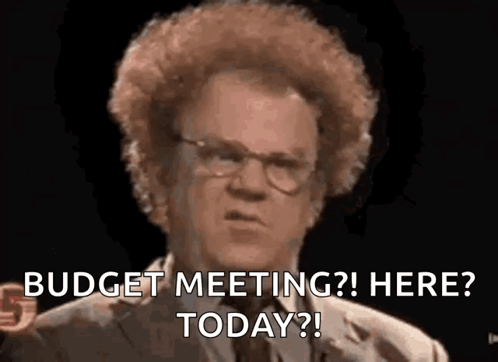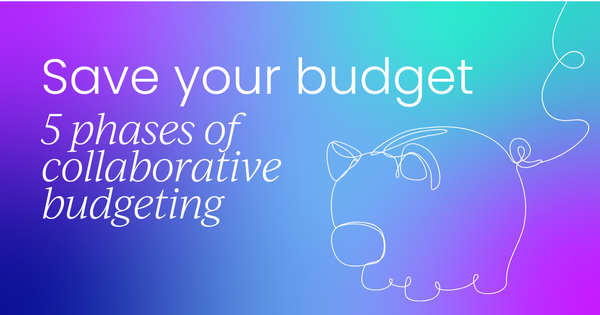Budgeting is often messy and difficult to get right. Unclear goals, unrealistic expectations, and isolated departments can make the process feel like a never-ending battle. All these issues can lead to budgets that collapse before they even get off the ground.
So, why does this happen?
Well, if numbers aren’t the problem, it could be a lack of teamwork. Meetings and top-down orders aren't always the right answer.

Instead, you need a structured approach to the budget process. This is where the five phases of collaborative budgeting come in.
Getting everyone on board can turn a chaotic budget into a united company plan that works. So, if your budget process is close to falling apart, here’s how the 5 phases of collaborative budgeting can save it.👇
1. Pre-kickoff: Setting the stage for success
The pre-kickoff phase is the preparation stage before formal budget talks begin. This is your chance to get everyone on the same page.
Teams must work together to build budget projections based on key goals, company priorities, and data. This phase also includes setting timelines and identifying who’ll be involved in the budgeting process.
But it’ll only work as a collaborative process when you get input from all departments. By doing this, you’ll create a budget grounded in reality that accurately reflects the needs of the entire company. It creates clarity you won't get if you work in a silo without help or input from others.
Success tips:
- Set clear objectives and identify what the budget is meant to achieve. Whether it’s growth, cost control, or innovation, jot those down and don’t leave them to collect dust. It would be best to communicate these goals to all stakeholders in a way they understand. In other words, avoid using complex financial jargon (if you can help it!).
- Compile historical financial data, market trends, and forecasts. This will give you a solid foundation for the upcoming planning.
- Decide who you need to get involved in the budgeting process. Ensure each department has a representative. Then, assign roles and responsibilities as needed.
2. Joint planning: Aligning goals across departments
The second phase of collaborative budgeting is joint planning. This will happen soon after the initial kick-off stage and requires bringing everyone together.
We’re talking department heads, stakeholders, the whole team. You need to set up joint planning sessions where everyone can present their budget proposals, along with their ideas, needs, and so on.
For this to work, you need to encourage transparent communication so that everyone can openly voice concerns and negotiate trade-offs. They can also see how their budget affects others.
3. Consolidation: Bringing it all together
Now that you have all the departmental budgets, it’s time to combine them into a single, unified corporate budget. This phase is your chance to :
- Resolve any differences
- Remove redundancies
- Create a realistic and achievable budget (within the company's financial limits)
By consolidating budgets, you can get a clearer picture of how resources are allocated across the company. Issues like overspending and underfunding are a lot easier to identify during this phase of the budgeting process.
Here’s how to do it:
- Review departmental budgets. Look for inconsistencies or overlaps in each budget.
- Use financial modeling tools. Use software that consolidates all budget data into a single view.
- Set priorities. Allocate resources to the most important areas of the business. This prevents departments from overspending or being underfunded for important initiatives.

4. Iteration: Refining the budget through feedback
The fourth stage is the iteration phase. Here, you'll gather feedback from all involved and adjust the budget. You may have to improve the initial plans based on what you learn and what ends up happening in real-time.
If you take time to iterate, you'll likely spot issues early, test for challenges, and make changes without delaying the budgeting process.
5. Final alignment: Getting everyone on the same page

You’ve made it to the final alignment phase. This is where you finalize the budget and get it signed off by all the stakeholders involved. It's basically the stage when all departments agree the budget is achievable and aligns with the company's goals.
Even a well-planned budget can fail if it lacks buy-in. Final alignment ensures that everyone - from finance to operations to leadership - is committed to the same financial plan.
Having this final alignment stage in the budgeting process creates a sense of shared ownership and accountability, which makes it more likely that everyone will stick to the budget.
Alright, so what does this phase look like in real life?
Here are a few tips to help make sure it goes smoothly:
- Hold a final review meeting. Get key stakeholders together to align on the budget.
- Communicate clearly. Share the finalized budget across the organization. Include clear instructions on its monitoring and responsibility for each part.
- Assign accountability. Each department must know who's responsible for managing their budget. They should also know how to report any variances or issues during the year.
FAQs
What do you mean by budget process?
The budget process is the series of steps organizations take to plan how they will allocate financial resources over a specific period, usually a year. It involves forecasting revenue, estimating expenses, and setting financial goals to guide decisions.
Why are budgets useful in the planning process?
Budgeting is the decision-making process for accepting and rejecting projects, making them useful because they act as a financial roadmap that helps guide companies when making decisions.
What are some key components of successful budgeting?
Key components include accurate revenue forecasting, realistic expense estimates, flexibility for adjustments, clear financial goals, and regular monitoring to track progress. Collaboration across departments also ensures all perspectives are considered.
What is the usual start point for a master budget?
The usual starting point for a master budget is the sales or revenue forecast. This forecast drives other components of the budget, as expected sales levels influence production, purchasing, and operational planning.
Want to learn more about the five phases of annual budgeting?
Enroll in our Budgeting & Forecasting Masters Certified Course and learn how to navigate each phase with confidence.
Gain the skills to:
- Create driver-based forecasts and scenario plans with increased accuracy.
- Lead the budgeting process from start to finish.
- Build robust financial models that withstand uncertainty and provide a solid foundation for strategic planning.
...and with Christian Wattig as your coach, you're in good hands!
Ready to take your budgeting skills to the next level?



 Follow us on LinkedIn
Follow us on LinkedIn




